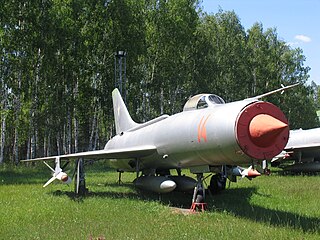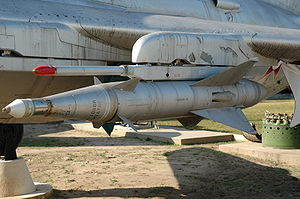
The Mikoyan-Gurevich MiG-19 is a Soviet second generation, single-seat, twinjet fighter aircraft, the world's first mass-produced supersonic aircraft. It was the first Soviet production aircraft capable of supersonic speeds in level flight. A comparable U.S. "Century Series" fighter was the North American F-100 Super Sabre, although the MiG-19 primarily fought against the more modern McDonnell Douglas F-4 Phantom II and Republic F-105 Thunderchief over North Vietnam. This aircraft was originally used by the Soviet Union but it was later used by the People's Liberation Army Air Force.

The Mikoyan-Gurevich MiG-17 is a high-subsonic fighter aircraft produced in the Soviet Union from 1952 and was operated by air forces internationally. The MiG-17 was license-built in China as the Shenyang J-5 and Poland as the PZL-Mielec Lim-6. The MiG-17 is still being used by the North Korean air force in the present day and has seen combat in the Middle East and Asia.

The Sukhoi Su-27 is a Soviet-origin twin-engine supermaneuverable fighter aircraft designed by Sukhoi. It was intended as a direct competitor for the large US fourth-generation jet fighters such as the Grumman F-14 Tomcat and McDonnell Douglas F-15 Eagle, with 3,530-kilometre (1,910 nmi) range, heavy aircraft ordnance, sophisticated avionics and high maneuverability. The Su-27 was designed for air superiority missions, and subsequent variants are able to perform almost all aerial warfare operations. It was designed with the Mikoyan MiG-29 as its complement.

The Mikoyan-Gurevich MiG-25 is a supersonic interceptor and reconnaissance aircraft that is among the fastest military aircraft to enter service. Designed by the Soviet Union's Mikoyan-Gurevich bureau, it is an aircraft built primarily using stainless steel. It was to be the last plane designed by Mikhail Gurevich, before his retirement.

The Sukhoi Su-7 is a swept wing, supersonic fighter aircraft developed by the Soviet Union in 1955. Originally, it was designed as a tactical, low-level dogfighter, but was not successful in this role. On the other hand, the soon-introduced Su-7B series became the main Soviet fighter-bomber and ground-attack aircraft of the 1960s. The Su-7 was rugged in its simplicity, but its Lyulka AL-7 engine had such high fuel consumption that it seriously limited the aircraft's payload, as even short-range missions required that at least two hardpoints be used to carry drop tanks rather than ordnance.

The Sukhoi Su-11 was an interceptor aircraft used by the Soviet Union during the Cold War.

The Sukhoi Su-15 is a twinjet supersonic interceptor aircraft developed by the Soviet Union. It entered service in 1965 and remained one of the front-line designs into the 1990s. The Su-15 was designed to replace the Sukhoi Su-11 and Sukhoi Su-9, which were becoming obsolete as NATO introduced newer and more capable strategic bombers.

The Soviet Air Defence Forces was the air defence branch of the Soviet Armed Forces. Formed in 1941, it continued being a service branch of the Russian Armed Forces after 1991 until it was merged into the Air Force in 1998. Unlike Western air defence forces, V-PVO was a branch of the military unto itself, separate from the Soviet Air Force (VVS) and Air Defence Troops of Ground Forces. During the Soviet period it was generally ranked third in importance of the Soviet services, behind the Strategic Rocket Forces and the Ground Forces.

The Vympel NPO R-77 missile is a Russian active radar homing beyond-visual-range air-to-air missile. It is also known by its export designation RVV-AE. It is the Russian counterpart to the American AIM-120 AMRAAM missile.

The Tupolev Tu-28 was a long-range interceptor aircraft introduced by the Soviet Union in the 1960s. The official designation was Tu-128, but this designation was less commonly used in the West. It was the largest and heaviest fighter ever in service.

The Sukhoi Su-9 was a single-engine, all-weather, missile-armed interceptor aircraft developed by the Soviet Union.

The Kaliningrad K-8 (R-8) was a medium-range air-to-air missile developed by the Soviet Union for interceptor aircraft use.

The Vympel K-13 is a short-range, infrared homing air-to-air missile developed by the Soviet Union. It is similar in appearance and function to the American AIM-9B Sidewinder from which it was reverse-engineered. Although it since has been replaced by more modern missiles in frontline service, it saw widespread service in many nations.
The MolniyaR-60 is a short-range lightweight infrared homing air-to-air missile designed for use by Soviet fighter aircraft. It has been widely exported, and remains in service with the CIS and many other nations.

The Vympel R-27 is a family of air-to-air missile developed by the Soviet Union. It remains in service with the Russian Air Force, air forces of the Commonwealth of Independent States and air forces of many other countries as standard medium range air-to-air missile even though they have the more advanced R-77.

The Shenyang J-11 is a twin-engine jet fighter of the People's Republic of China whose airframe is derived from the Soviet-designed Sukhoi Su-27. It is manufactured by the Shenyang Aircraft Corporation (SAC). The aircraft is operated by the People's Liberation Army Air Force (PLAAF) and the People's Liberation Army Naval Air Force (PLANAF).

The Kh-25/Kh-25M is a family of Soviet lightweight air-to-ground missiles with a modular range of guidance systems and a range of 10 km. The anti-radar variant (Kh-25MP) is known to NATO as the AS-12 'Kegler' and has a range up to 40 km. Designed by Zvezda-Strela, the Kh-25 is derived from the laser-guided version of the Kh-23 Grom. The Kh-25 remains in widespread use despite the apparent development of a successor, the Kh-38.

The Zvezda Kh-66 and Kh-23 Grom are a family of early Soviet tactical air-to-surface missiles with a range of 10 km. They were intended for use against small ground or naval targets. The Kh-66 was effectively a heavy-warhead, beam-riding version of the K-8 air-to-air missile rushed into service in Vietnam in 1968. The Kh-23 was an improved Kh-66 with command-guidance, similar to the AGM-12 Bullpup.
The Mikoyan-Gurevich I-75 was the final design of a series of three experimental swept-wing interceptors developed in the Soviet Union in the mid-late 1950s by the Mikoyan-Gurevich design bureau from their Mikoyan-Gurevich I-3 airframe. All the aircraft in the I-3 program were affected by delays in the development of the Klimov VK-3 turbojet engine, its cancellation and ultimate replacement by the Lyulka AL-7F turbojet engine.


















